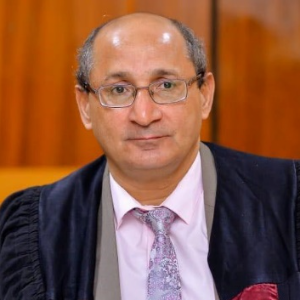Ephraim Suhir, Portland State University, United States
The fundamentals of a body of knowledge that could be identified as fiber optics structural analysis (FOSA) are addressed. The emphasis is on the application of analytical ("mathematical") predictive modeling, as well as on the probabilistic design for reliability (PDfR [....] » Read More


























Title : Nanoscale tilt measurement with improvised optical interferometric configurations
A R Ganesan, Indian Institute of Technology Madras, India
The applications of the measurement of small tilt angle range from leveling devices to planetary measurement, X Ray interferometers, coordinate measurement methods etc. Non Interferometric methods such as collimators, laser triangulation cannot measure tilts below a fraction of r [....] » Read More
Title : From passive light to smart light: The role of AI in the next generation of optical networks
Mohamed Essam Khedr, Arab Academy for Science, Egypt
The evolution of optical networks from passive light transmission to intelligent, adaptive systems signifies a paradigm shift in telecommunications. This talk investigates the importance of artificial intelligence (AI) in developing future-generation optical networks, which are e [....] » Read More
Title : Frontiers of lens-less instrumentation as a fundamental basis for pure scientific, applied biomedical and biotechnological, food agricultural and industrial applications. From know how history to the future
Oleg V Gradov, Federal Research Center for Chemical Physics of the Russian Academy of Sciences, Russian Federation
A brief description of the novelty positions and chronology of the research performed by O.V. Gradov group (since 2010 to 2019 - from pure lensless biomicroscopy to the principles of converting non-optical signals into optical ones and diversification of the lensless measurement [....] » Read More
Title : Theoretical investigation of spectral characteristics of CW CO lasers
Utpal Nundy, Raja Ramanna Centre for Advanced Technology, India
In free running mode of operation, Continuous wave (CW) CO (carbon monoxide) lasers emit a continuous beam of coherent light over a range of wavelengths, in the mid-infrared region. This wavelength range is particularly useful for studying molecular vibrations and rotations, maki [....] » Read More
Title : Bottom-up plasmonic microstructures for Surface Enhanced Raman Spectroscopy (SERS)
Anand Dev Ranjan, IISER Kolkata, India
Raman spectroscopy is a non-invasive, label-free, and extremely sensitive technique for detecting a wide variety of molecules. Although Raman is a highly effective experimental technique, its narrow scattering cross-section reduces signal strength, resulting in a low signal-to-no [....] » Read More
Title : Innovative photonic architectures for bio-sample detection through refractive index sensing
Pukhrambam Puspa Devi, National Institute of Technology Silchar, India
This presentation delves into the transformative advancements in photonic technology and its potential to replace traditional electronic devices by exploiting photonic properties through engineered structures. The discussion centers on various photonic crystal (PhC) configuration [....] » Read More
Title : Optical fiber VOCs gas sensors development working at room temperature
Jin Li, Northwest A&F University, China
Semiconductor nanomaterials-based gas sensors can sensitively distinguish the concentration of volatile organic compounds (VOCs) gases with extremely low detection limits. However, the semiconductor nanomaterials must be maintained at high temperatures to provide the optimal cata [....] » Read More
Title : Super-resolution image reconstruction framework based on the joint spatial-frequency reconstruction method
Tianyu Zhao, Xian Jiaotong University, China
Super-resolution structured illumination microscopy (SR-SIM) is finding increasing application in biomedical research due to its capacities of high-speed imaging and minimzing photodamage, which is superior capability to visualize the subcellular dynamics in living cells. However [....] » Read More
Title : Synthesis and characterization of luminescent polymer nanocomposite films (YPO4:Pr3+/ polystyrene for solid-state lighting applications
Kahouadji Badis, University of Bejaia, Algeria
Luminescent polymer films are promising for future optoelectronic devices owing to their ease of synthesis, tunable properties and flexibility. The present work reports on the fabrication of YPO4:Pr3+/polystyrene based flexible and luminescent nanocomposite (NC) films followed by [....] » Read More
Title : All-fiber passive Q-switched laser at 1072 nm based on hybrid organic small molecules as a saturable absorber with a high output power
Sameer Salam, Imam Jaafar Al-Sadiq University, Iraq
We used a hybrid organic small molecule (HOSM) based Alq3 and NPB as a saturable absorber (SA). The developed SA has a modulation depth of ~ 20% and saturation intensity of 4.8 MW/cm2. At 1072 nm, the SA exhibits absorption of approximately 0.8%. The cavity setup we addressed in [....] » Read More
Title : Improving the fatigue design of mechanical systems such as refrigerator
Seongwoo Woo, Addis Ababa Science & Technology University, Ethiopia
To enhance the lifetime of mechanical system such as automobile, new reliability methodology – parametric Accelerated Life Testing (ALT) – suggests to produce the reliability quantitative (RQ) specifications—mission cycle—for identifying the design defects [....] » Read More
Title : The solution of the SCHRODINGER equation from the link between quantum mechanics and relativity
Mohamed Daris, Rabat-Morocco, Morocco
I will study the link between the quantum mechanics and relativity and I transform this study to another level so I will demonstrate the solution of the Schrodinger equation from the link between quantum mechanics and relativity so in this case I will put a system of solutions eq [....] » Read More
Title : Coherent perfect absorption in metal-dielectric composites: Theory and recent application
Sanjeeb Dey, Ramakrishna Mission Vidyamandira, India
This work explores coherent perfect absorption (CPA) in metal-dielectric composite medium (CM) under bidirectional illumination (plane waves or Gaussian beams). CPA conditions are derived for normal and oblique incidences. It is observed that broad beams enable CPA through paraxi [....] » Read More
Title : Measurements of Angstrom exponent of aerosol by ozone lidar with four wavelengths
Nianwen Cao, Nanjing University of Information Science & Technology, China
Simulation of the Angstrom exponent k of aerosol from synthetic ozone lidar signals at three wavelengths and measurements of the Angstrom exponent k aerosol from ozone Lidar at four wavelengths were presented in this paper. Ozone Lidar signals were simulated at three wavelengths [....] » Read More
Title : Smart surveillance with 5G: A performance study in Adama city
Shenko Chura Aredo, Adama Science and Technology University, Ethiopia
In light of Adama City’s smart city development vision, this study thoroughly investigates the performance of smart security systems with Fifth Generation (5G) network capabilities. It can be logistically difficult to install a lot of cabling, particularly in big or dynamic [....] » Read More
Title : Experimental and numerical study of Ce1-xFexO2 thin films for photovoltaic applications
Jamal Zimou, Universite Ibn Tofail, Kenitra, Morocco
This work focuses on the synthesis and characterization of undoped and Fe-doped Cerium dioxide thin film. Moreover, it focuses on the numerical simulation of the CeO2-based solar cell using the SCAPS-1D software. The undoped and Fe-doped Cerium dioxide thin films at different [....] » Read More